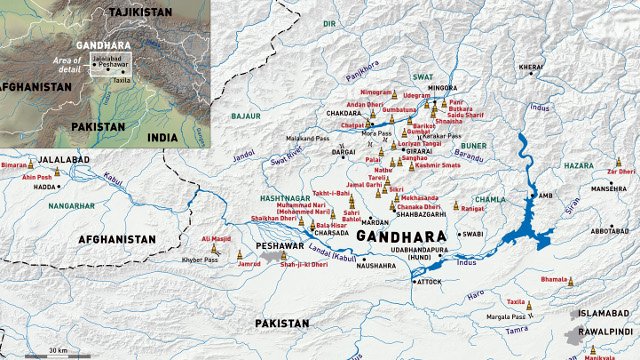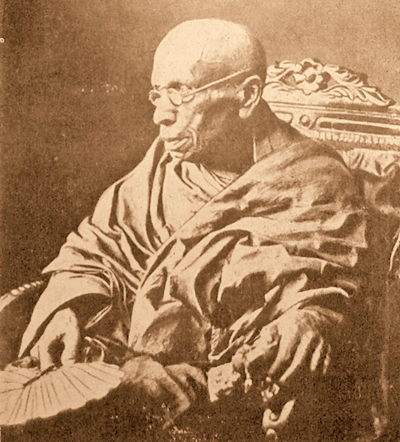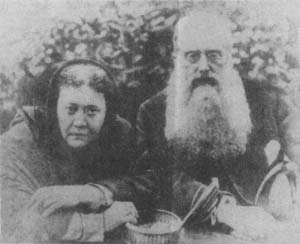A brief history
by Barbara O’Brien, ‘Thoughtco,’ July 23, 2018
When Buddhism spread beyond India, the first nations in which it took root were Gandhara and Ceylon, now called Sri Lanka. Since Buddhism eventually died out in India and Gandhara, it can be argued that the oldest living Buddhist tradition today is found in Sri Lanka.
 Today about 70 percent of the citizens of Sri Lanka are Theravada Buddhists. This article will look at how Buddhism came to Sri Lanka, once called Ceylon; how it was challenged by European missionaries; and how it was revived.
Today about 70 percent of the citizens of Sri Lanka are Theravada Buddhists. This article will look at how Buddhism came to Sri Lanka, once called Ceylon; how it was challenged by European missionaries; and how it was revived.
How Buddhism Came to Ceylon
The history of Buddhism in Sri Lanka begins with Emperor Ashoka of India (304 – 232 BCE). Ashoka the Great was a patron of Buddhism, and when King Tissa of Ceylon sent an emissary to India, Ashoka seized the opportunity to put in a good word about Buddhism to the King.
Without waiting for a reaction from King Tissa, the Emperor sent his son Mahinda and his daughter Sanghamitta — a monk and a nun — to Tissa’s court. Soon the King and his court were converted.
For several centuries Buddhism flourished in Ceylon. Travelers reported many thousands of monks and magnificent temples. The Pali Canon was first written in Ceylon. In the 5th century, the great Indian scholar Buddhaghosa came to Ceylon to study and write his famous commentaries. Beginning in the 6th century, however, political instability within Ceylon combined with invasions by the Tamils of southern India caused support for Buddhism to decline.
From the 12th through 14th centuries Buddhism regained much of its former energy and influence. Then it faced its greatest challenge — Europeans.
Mercenaries, Merchants, and Missionaries
Lourenco de Almeida (died 1508), a Portuguese sea captain, landed on Ceylon in 1505 and established a port at Colombo. At the time Ceylon was divided into several warring kingdoms, and the Portuguese took advantage of the chaos to gain control of the island’s coasts.
The Portuguese had no tolerance for Buddhism. They destroyed monasteries, libraries, and art. Any monk caught wearing a saffron robe was executed. According to some accounts — possibly exaggerated — when the Portuguese finally were expelled from Ceylon in 1658 only five fully ordained monks remained.
The Portuguese were expelled by the Dutch, who took control of the island until 1795. The Dutch were more interested in commerce than in Buddhism and left the remaining monasteries alone. However, the Sinhalese discovered that under Dutch rule there were advantages to becoming Christian; Christians had higher civil status, for example. The converted were sometimes referred to as “government Christians.”
During the upheaval of the Napoleonic Wars, Britain was able to take Ceylon in 1796. Soon Christian missionaries were pouring into Ceylon. The British government encouraged Christian missions, believing Christianity would have a “civilizing” effect on the “natives.” The missionaries opened schools throughout the island to convert the people of Ceylon from their “idolatry.”
By the 19th century, Buddhist institutions in Ceylon were moribund, and the people were largely ignorant of the spiritual tradition of their ancestors. Then three remarkable men turned this state of affairs on its head.

Mohotti Watte Gunananda
The Revival
In 1866, a charismatic young monk named Mohottivatte Gunananda (1823-1890) challenged the Christian missionaries to a great debate. Gunananda was well prepared. He had studied not only the Christian scriptures but also rationalist writings of the West that criticized Christianity. He had already been traveling around the island nation calling for a return to Buddhism and attracting thousands of rapt listeners.
In a series of debates held in 1866, 1871, and 1873, Gunananda alone debated the foremost missionaries in Ceylon on the relative merits of their religions. To the Buddhists of Ceylon, Gunananda was the hands-down winner each time.
In 1880 Gunananda was joined by an unlikely partner — Henry Steel Olcott (1832-1907), a New York customs lawyer who had given up his practice to seek the wisdom of the East. Olcott also traveled throughout Ceylon, sometimes in the company of Gunananda, distributing pro-Buddhist, anti-Christian tracts. Olcott agitated for Buddhist civil rights, wrote a Buddhist Catechism still in use today, and founded several schools.
:max_bytes(150000):strip_icc():format(webp)/H.S._Olcott-portrait-300-56a0c4585f9b58eba4b3a43a.jpg)
Henry Steel Olcott
In 1883, Olcott was joined by a young Sinhalese man who had taken the name Anagarika Dharmapala. Born David Hewivitarne, Dharmapala (1864-1933) had been given a thoroughly Christian education in Ceylon’s missionary schools. When he chose Buddhism over Christianity, he took the name Dharmapala, which means “protector of the dharma,” and the title Anagarika, “homeless one.” He did not take full monastic vows but lived the eight Uposatha vows daily for the rest of his life.
Dharmapala joined the Theosophical Society that had been founded by Olcott and his partner, Helena Petrovna Blavatsky, and became a translator for Olcott and Blavatsky. However, the Theosophists believed all religions have a common foundation, a tenet Dharmapala rejected, and he and the Theosophists eventually would part ways.
Dharmapala worked tirelessly to promote the study and practice of Buddhism, in Ceylon and beyond. He was particularly sensitive to the way Buddhism was being presented in the West. In 1893 he traveled to Chicago to the World Parliament of Religions and presented a paper on Buddhism that emphasized Buddhism’s harmony with science and rational thinking. Dharmapala influenced much of the West’s impression of Buddhism.
After the Revival
In the 20th century, the people of Ceylon gained more autonomy and eventually independence from Britain, becoming the Free Sovereign and the Independent Republic of Sri Lanka in 1956. Sri Lanka has had more than its share of upheavals since. But Buddhism in Sri Lanka is as strong as it has ever been.
Henry Steel Olcott’s Unlikely Life
The White Buddhist of Ceylon

Madame Blavatsky and Henry Steel Olcott
Henry Steel Olcott (1832-1907) lived the first half of his life the way a respectable gentleman was expected to live in 19th century America. He served as a Union officer in the U.S. Civil War and then built a successful law practice. And in the second half of his life he traveled to Asia to promote and revive Buddhism.
Henry Steel Olcott’s unlikely life is better remembered in Sri Lanka than in his native America.
Sinhalese Buddhists light candles in his memory every year on the anniversary of his death. Monks offer flowers to his golden statue in Colombo. His image has appeared on Sri Lanka postage stamps. Students of Sri Lanka’s Buddhist colleges compete in the annual Henry Steel Olcott Memorial Cricket Tournament.
Exactly how an insurance lawyer from New Jersey became the celebrated White Buddhist of Ceylon is, as you might imagine, quite a tale.
Olcott’s Early (Conventional) Life
Henry Olcott was born in Orange, New Jersey, in 1832, to a family descended from the Puritans. Henry’s father was a businessman, and the Olcotts were devout Presbyterians.
After attending the College of the City of New York Henry Olcott entered Columbia University. The failure of his father’s business caused him to withdraw from Columbia without graduating. He went to live with relatives in Ohio and developed an interest in farming.
He returned to New York and studied agriculture, founded an agricultural school, and wrote a well-received book on growing types of Chinese and African sugar cane. In 1858 he became the agriculture correspondent for the New York Tribune. In 1860 he married the daughter of the rector of Trinity Episcopal Church in New Rochelle, New York.
At the beginning of the Civil War he enlisted in the Signal Corps. After some battlefield experience, he was appointed a Special Commissioner for the War Department, investigating corruption in recruitment (mustering) offices. He was promoted to the rank of Colonel and assigned to the Department of the Navy, where his reputation for honesty and industriousness earned him an appointment to the special commission that investigated President Abraham Lincoln’s assassination.
He left the military in 1865 and returned to New York to study law. He was admitted to the bar in 1868 and enjoyed a successful practice specializing in insurance, revenue, and customs law.
To that point in his life, Henry Steel Olcott was the very model of what a proper Victorian-era American gentleman was supposed to be. But that was about to change.
Spiritualism and Madame Blavatsy
Since his Ohio days, Henry Olcott had harbored one unconventional interest — the paranormal. He was especially fascinated by spiritualism, or the belief that the living can communicate with the dead.
In the years after the Civil War, spiritualism, mediums and seances became a widespread passion, possibly because so many people had lost so many loved ones in the war.
Around the country, but especially in New England, people formed spiritualist societies to explore the world beyond together.
Olcott was drawn into the spiritualist movement, possibly to the consternation of his wife, who sought a divorce. The divorce was granted in 1874. That same year he traveled to Vermont to visit some well-known mediums, and there he met a charismatic free spirit named Helena Petrovna Blavatsky.
There was little that was conventional about Olcott’s life after that.
Madame Blavatsy (1831-1891) had already lived a life of adventure. A Russian national, she married as a teenager and then ran away from her husband. For the next 24 or so years, she moved from one place to another, living for a time in Egypt, India, China, and elsewhere. She claimed also to have lived in Tibet for three years, and she may have received teachings in a tantric tradition.
Some historians doubt a European woman visited Tibet before the 20th century, however.
Olcott and Blavatsky blended together a mix of Orientalism, Transcendentalism, spiritualism, and Vedanta — plus a bit of flim-flam on Blavatsky’s part — and called it Theosophy. The pair founded the Theosophical Society in 1875 and began publishing a journal, Isis Unveiled, while Olcott continued his law practice to pay the bills. In 1879 they moved the Society’s headquarters to Adyar, India.
Olcott had learned something about Buddhism from Blavatsky, and he was eager to learn more. In particular, he wanted to know the Buddha’s pure and original teachings. Scholars today point out that Olcott’s ideas about “pure” and “original” Buddhism largely reflected his 19th-century western liberal-transcendentalist romanticism about universal brotherhood and “manly self-reliance,” but his idealism burned brightly.
The White Buddhist
The following year Olcott and Blavatsky traveled to Sri Lanka, then called Ceylon. The Sinhalese embraced the pair with enthusiasm. They especially were thrilled when the two white foreigners knelt to a large statue of the Buddha and publicly received the Precepts.
Since the 16th century Sri Lanka had been occupied by Portuguese, then by Dutch, then by British. By 1880 the Sinhalese had been under British colonial rule for many years, and the British had been aggressively pushing a “Christian” education system for Sinhalese children while undermining Buddhist institutions.
The appearance of white westerners calling themselves Buddhists helped to begin a Buddhist resurgence that in decades to come would turn into a full-blown rebellion against colonial rule and the forced imposition of Christianity.
Plus it grew into a Buddhist-Sinhalese nationalism movement that impacts the nation today. But that is getting ahead of Henry Olcott’s story, so let’s go back to the 1880s.
As he traveled Sri Lanka, Henry Olcott was dismayed at the state of Sinhalese Buddhism, which seemed superstitious and backward compared to his liberal-transcendentalist romantic vision of Buddhism. So, ever the organizer, he threw himself into re-organizing Buddhism in Sri Lanka.
The Theosophical Society built several Buddhist schools, some of which are prestigious colleges today. Olcott wrote a Buddhist Catechism for that is still in use. He traveled the country distributing pro-Buddhist, anti-Christian tracts. He agitated for Buddhist civil rights. The Sinhalese loved him and called him the White Buddhist.
By the mid-1880s Olcott and Blavatsky were drifting apart. Blavatsky could charm a drawing-room of spiritualist believers with her claims of mysterious messages from invisible mahatmas. She was not so interested in building Buddhist schools in Sri Lanka. In 1885 she left India for Europe, where she spent the rest of her days writing spiritualist books.
Although he made some return visits to the U.S., Olcott considered India and Sri Lanka his homes for the rest of his life. He died in India in 1907.